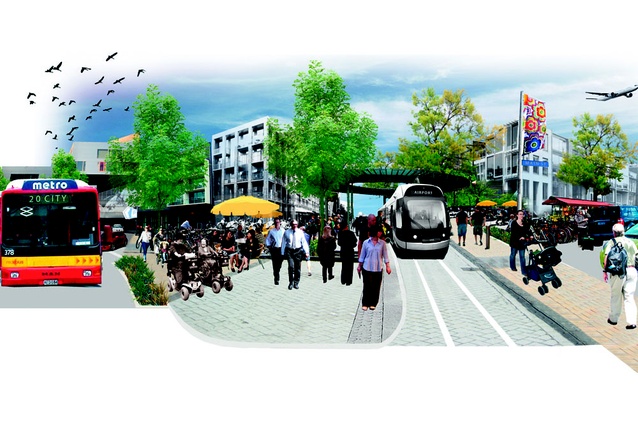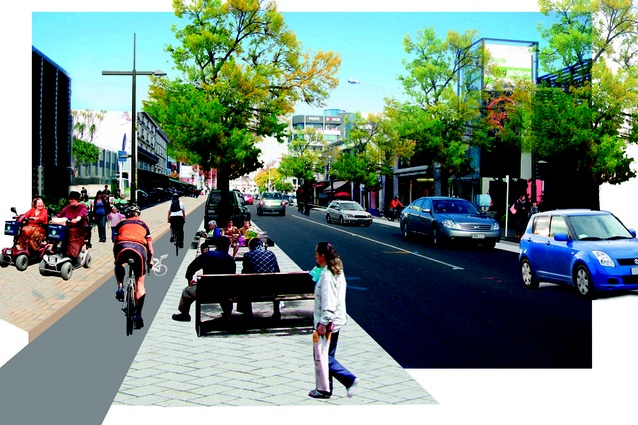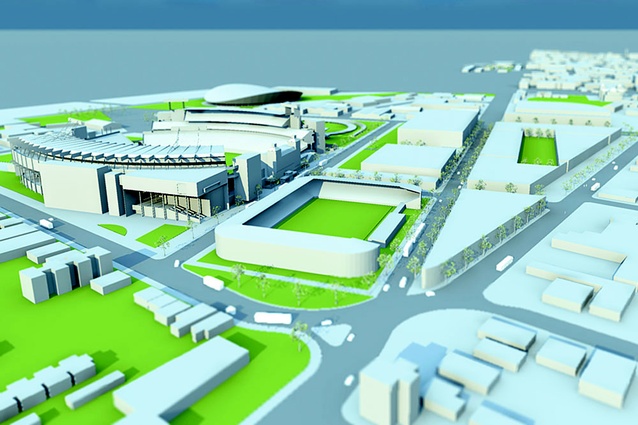The challenge of Christchurch
Ian Athfield chronicles the challenging journey taken since being appointed to the role of Architectural Ambassador for post-earthquake Christchurch.
For those who have been close to the destructive events which occurred in Christchurch it is extremely difficult to remove oneself from the magnitude of the task facing the city’s future. Thirteen months after the first quake, sitting watching the tide move slowly in over the sands of Awaroa in the Abel Tasman National Park, I am able to reflect on the subject without the confusion of the many voices and images that have been roused and drawn within Christchurch and beyond.
The first earthquake struck on 4 September 2010 at 4:35am, centred close to Darfield some 40km from the heart of Christchurch, and measuring 7.1 on the Richter scale. It caused the most structural damage in New Zealand since the 1931 Hawke’s Bay earthquake. Within 24 hours many property owners and associated professions were emailed by structural engineers offering advice on the integrity of buildings and land. Geotechnical and structural engineers were marshalled together within a week to assist on evaluations, and presented a cohesive and creditable resource for offering advice. During the next week the New Zealand Institute of Architects (NZIA), through the CEO Beverley McRae, the president Patrick Clifford, and the chair of the Canterbury branch Jasper Van de Linden, decided to offer the Christchurch City Council (CCC) an individual architect to co-ordinate a collective group of local architects who would offer advice on the future rebuild of Christchurch. On 14 September 2010, the role of Architectural Ambassador was placed on me, with the endorsement of the Mayor of Christchurch Bob Parker.
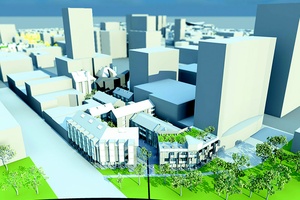
During early meetings among 30 to 40 Christchurch architects, it was resolved that the task which lay ahead of establishing a design-led direction for the city was too problematic. At this early stage it was decided that the architectural community was best placed to advise the greater Christchurch and New Zealand communities of the issues facing a city where change and vision would be a large part of decision making. The voices of the various factions of Christchurch society and other allied professions reinforced the conclusion to inform rather than dictate the direction in which the city may evolve. An exhibition was proposed dealing with the following five issues: Environmental Planning, Heritage & Character, Urban Design, Residential & Transport and Infrastructure. Each platform was to be supported by a public lecture discussing the issues at hand and the longer term economic and social effects of such a devastating event.
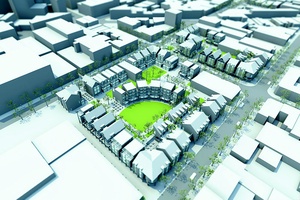
This evolved into the BEFORE AFTER Exhibition and Discussion Series which was realised through sponsorship from the CCC, the Warren Architects’ Education Charitable Trust, the New Zealand Institute of Architects and New Zealand Steel. The exhibition opened in the Christchurch Art Gallery on 11 February 2011 and the first public lecture was held on 17 February. Both events attracted a high level of public interest and support. At 12:51pm on Tuesday, 22 February 2011 the second quake of magnitude 6.3 struck Christchurch. This earthquake was centred in Lyttelton Harbour, an area previously not anticipated to be affected. The earthquake devastated central Christchurch and many surrounding suburbs. One hundred and eighty-one lives were lost and many more were injured. A national state of emergency was declared. The exhibition and lecture series abruptly stopped. Questions asked by the September earthquake were answered by the February quake and further reinforced by a later event on 13 June. Heritage and character structures previously considered restorable fell apart and many post-1960 buildings previously considered earthquake resistant also suffered extensive damage. Above all of this, it was the heritage structures around which Christchurch had built its reputation that crumbled the city’s confidence and left a landscape punched full of holes. In this new devastated environment the architectural voice was not encouraged, understood or respected.
Attention turned to making the city safe and dealing with liquefied ground conditions and inadequate foundations. The cost of remediation of land and the demolition of structures deemed to be unsafe became the main focus of activity. In mid-March, I was given the opportunity to speak to Christchurch property owners based in Sydney and took the chance to voice my personal belief that Christchurch’s urban problems commenced some five decades before these earthquakes and as a result the city was governed by dysfunctional end-use policies and an absolute faith in traffic engineers and transportation consultants. I suggested that all one-way streets within the four avenues be changed back to a slow moving two-way system, and that unnecessary public transport movements through the CBD be drastically reduced. My utterances were reported in The Press before I returned home the next morning and were followed by a string of reactions encouraging me to never show my face in Christchurch again. Fortunately I received many whispers of endorsements from unexpected citizens and traffic engineers who had become frustrated by the inability to implement change.
The Canterbury Earthquake Recovery Authority (CERA) was established by the government following the 22 February earthquake with far reaching legislative and regulatory power. CERA’s initial responsibility of ensuring public safety; the demolition of badly damaged structures and the determination of the suitability of land for rebuilding or acquisition, has meant that expectations of a complementary and pivotal role in determining the future of the Canterbury region has not eventuated. In late March, the CCC was given the responsibility of re-planning the central city defined by Deans, Moorhouse, Bealey and Fitzgerald Avenues including Hagley Park. The balance of Christchurch’s urban area and surrounding rural land remained the responsibility of CERA. CCC has faced a difficult challenge by being asked to re-plan the central city in isolation without being able to analyse the full effects of the changes in the surrounding suburban areas. Throughout this period, local architects have continued to meet regularly to debate issues and explore ways to influence the city and future shape of Christchurch. Although a planning group was formed within CCC to look at the draft Central City Plan, no local architects were asked to take part in this key decision-making body. Despite this failure to be able to work with the CCC in a professional multi-disciplinary design team, the Christchurch architects voluntarily gave their time to produce a submission to the council titled Recommendations for a Design Led Reconstruction of the Christchurch City Centre. Excerpts from this submission are included below.
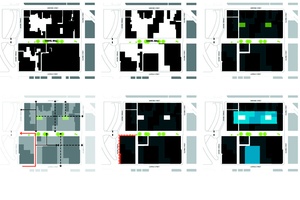
From these meetings, David Sheppard and I were commissioned by the Cashel Mall retailers, through Richard Ballantyne of Ballantynes Department Store, to co-ordinate the future direction of land owners abutting Cashel Mall, between Oxford Terrace, Lichfield Street, Hereford Street and Colombo Street. This small but meaningful commission gave us the opportunity to explore a number of ideas towards a future for Christchurch. Between March and early August we met regularly with the Cashel Mall property owners and their architectural consultants to develop a future direction for these two critical city blocks and a solution which would be economic in the long-term for this area. This was undertaken in conjunction with the Re:Start initiative guided by The Buchan Group, who have been working towards the re-establishment of permanent and temporary retail in the precinct. During the process, various drawings were produced to discuss strategies for the precinct’s future growth and rebuild. In addition we produced a series of diagrams and plans indicating how we saw the future of the central city in relationship to the Cashel Mall area.
While working with this collective body of diverse property owners, one of the most disappointing challenges within Cashel Mall was the loss of the Bell building’s Venetian façade. A considerable effort by the owner, his architect Philip Kennedy, the Historic Places Trust, Winn Clark and Alastair Cattanach, senior earthquake engineers and my team failed to save this façade. The perceived safety of keeping it in position during reconstruction as well as the inability to be covered by insurance, with the requirement for the owner to carry all risk and the final cost, meant that this important façade had to be given away. This exercise demonstrated how difficult it is to save remnants of heritage when considerable damage has been done to the remainder of the building and when the quality of the foundations are questionable. The draft Central City Plan was made public at the end of August and the broad direction taken met with general public and professional support. Personally, the reversion to a two-way street system and the reduction of unnecessary public transport through the square and principal shopping streets was heartening. Concern has increased over the assumptions that the rebuild will create an instant, permanent city and that the rules and regulations accompanying the vision are derived from the previous city. Many of the recommendations were made prior to the extent of demolition now becoming apparent within the central city.
The projected number of buildings demolished will now be approximately 60 per cent of the previous building stock. The buildings include many high rises and a number of well-loved but poorly occupied structures. The owners of the sites where buildings have been demolished face the challenge of rebuild and in many cases, on a reduced scale to what was previously there. Uncertainties about where new building occupants will come from and insurance decisions have led owners to question whether they can afford to build at this stage. Many potential tenants have now committed to long-term leases in outer suburban areas. The challenge within the central city is to provide occupation for those activities which give a strong point of difference to that given by outlying commercial and retail areas. A revitalised central city will need to provide active areas of entertainment to complement the remaining museum and art gallery facilities along with competing food and restaurant offerings. For these activities to exist requires, in the main, ground floor addresses and low rentals. Affordable rents cannot be achieved by building instant, permanent buildings with a minimum of three storeys and a maximum of seven. There is a very strong case to allow simple, low-rise, well designed, re-locatable buildings to link the remaining existing structures of the city in a clear and coherent expression of the beginning of a new focus, while long-term decisions are clearly thought through by intelligent minds working together. Long-term decisions can build on this fabric. One cannot expect to begin with the end result; a nurturing environment must be provided as a seed from which a city can grow meaningfully. Architects, who have been generally ignored and misjudged by the city as superficial and designers of isolated objects, must play a part in the collective mind and the future resolution of this immense challenge.
The earthquakes have magnified the reliance on pattern making by the motorcar instead of dealing with the respecting of communities. The challenge of Christchurch and the settlement pattern that must be addressed is an invaluable lesson to the rest of New Zealand and urban societies throughout the developed world. Over a year has now passed since the first earthquakes. The vision which looks at the total settlement of Christchurch to the benefit of the balance of its people has yet to be made. The low density, poorly serviced out-lying areas will not go away and those embarrassing suburban malls cannot be ignored. Denial of the collective involvement of architects, landscapers, designers, engineers and planners will lead to individual disenchantment and needy professionals looking for a meal. Some get the fruitcake and others the crumbs from the large infrastructure table. The recent history of starving the creative mind can perpetuate self-indulgence and restrict the positive contribution that a collective mind can offer. Is it too late?

